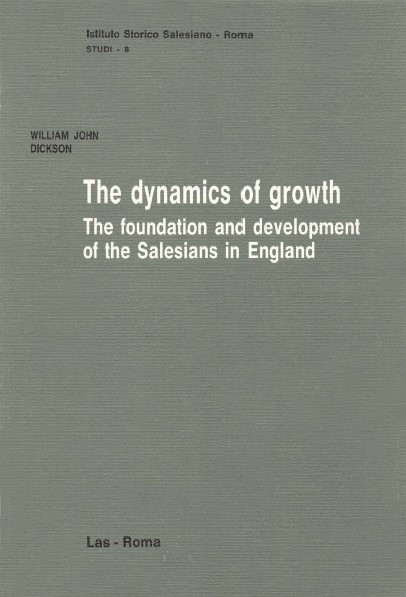What follows is an attempt to write a history of the foundation and development of the Salesians in England, from the origins in the 1940s up to 1930, with a postscript on the crisis of 1939-40.
The closing date was determined by the fact that the Archivio centrale salesiano in Rome is closed to researchers from 1931. The research is based largely on archival material which was in great part unavailable to earlier writers.
Quello che segue è un tentativo di scrivere una storia della fondazione e dello sviluppo dei Salesiani in Inghilterra, dalle origini negli anni Quaranta fino al 1930, con un post-scritto sulla crisi del 1939-40. La data di chiusura è stata determinata dal fatto che l’Archivio centrale salesiano di Roma è chiuso ai ricercatori dal 1931. La ricerca si basa in gran parte su materiale d’archivio, in gran parte inaccessibile agli scrittori precedenti.
Index:
- Foreword
- Primary sources: Archives consulted, abbreviations used
- Chapter one – Introduction and review of the literature
- 1. The original inspiration of the Salesians
- Chapter two – An Italian vision of England
- 1. The Italian liberal view of England
- 2. The British liberal Italian connection
- 3. The Italian catholic view of England
- 4. Laurence Gastaldi and the English mission
- 5. Gastaldi, don Bosco and England
- 6. Gastaldi and Dominic Savio’s day dream
- Chapter three – The vision through Irish eyes
- 1. Don Bosco, the Irish college and the missionary venture
- 2. The subsequent success of the Irish connection
- 3. The Donnellan letters
- 3.1 First impressions
- 3.2 Don Bosco, absent from the Oratory
- 3.3 The other Irish student
- 3.4 The nature of the Oratory
- 3.5 The lrish grievances
- 3.6 The Italian diet
- 3.7 The style of discipline
- 3.8 Diocesan priests or Salesians?
- 3.9 The parting of friends
- 3.10 The death of Archbishop Gastaldi
- 3.11 The results of the conflict
- 3.12 Carnival
- 3.13 Donnellan’s deteriorating health
- 3.14 The critical breakdown
- 3.15 The end of the story
- 3.16 Some conclusions
- Chapter four – Battersea: a nightmare settings
- 1. The general background
- 2. The Religious background
- 3. The Catholic background
- 3.1 The Canon, the Countess and the Bishop
- 3.2 Table of statistics
- 3.3 Names from Liber Baptizatorum, West Battersea
- Chapter five – Laying the foundation in Battersea
- 1. The Countess, the Bishop and Rome
- 2. Battersea, Francis Bourne and Bishop Butt
- 3. Seeing the difficulties
- 4. Fr Dalmazzo’s visit
- 5. The arrival
- 5.1 The first year: a vision disillusioned
- 5.2 A sad beginning
- 5.3 The problem of destitution
- 5.4 The contract
- 6. Life at Battersea
- 7. Fr MacKiernan’s illness
- Chapter six – The years of growth (1889-1898)
- 1. Don Rua and Fr MacKiernan’s successor
- 2. The years of expansion at Battersea(1889-1902)
- 2.1 Statistics of growth
- 2.2 Growth factors
- 2.3 The question of the contract
- 3. The growth of the schools
- 4. The growth of vocations
- 5. More accomodation
- 6. Catholic secondary education
- 7. Bulding the Sacred Heart Church
- 8. Laying the foundation stone
- 9. Some problems associated with rapid development
- 10. The position of the Coadjutor Brothers
- Chapter seven – Becoming a province (1898-1908)
- 1. Charles Bernard Macey
- 2. Financial problems
- 3. Trusting the local Superior
- 4. The schools at Battersea
- 5. The initial expansion: Burwash
- 6. Cape Town 1897
- 7. Chertsey and the Daughters of Mary Help of Christians
- 8. East Hill and Southwark
- 9. Farnborough
- 10. Conclusion
- Chapter eight – The vision fades: a crisis of growth (1908-1918)
- 1. Running out of charisma
- 2. The extraordinary visitation of 1908
- 2.1 The house reports
- 2.2 The Superiors
- 2.3 Chastity and morality
- 2.4 Don Bosco and assistance
- 2.5 Community life
- 2.6 Military Chaplains
- 2.7 The students
- 2.8 Conclusions
- 3. The extraordinary visitations worldwide
- 4. A question of numbers
- 5. A new Provincial
- 5.1 His reception
- 5.2 Anti-Italian feeling
- 5.3 Fr Scaloni’s administration
- 5.4 Fr Goy’s protest
- 5.5 Fr Scaloni’s reply
- 6. The impact of War 1913-1918
- 6.1 Anti-Italianism
- 6.2 Fr Scaloni’s absence
- 7. The problem of Farnborough
- 8. Macey-Simonetti
- 9. Daily life in a Salesian school
- 10. Salesian features of school life
- 11. Conclusions
- Chapter nine – A vision reborn: hopes for the future (1919-1926)
- 1. Post war revival
- 1.1 Problems to be faced
- 1.2 Fr Sutherland and Ireland
- 2. Fr Simonetti’s support
- 3. The foundation of Pallaskenry
- 4. Fr Scaloni’s return
- 5. Fr Angelo Franco
- 6.The second foundation in Ireland
- 7.Sound hopes for the not too distant future
- 8. Foundation in the North of England
- 9. Some sadder moments
- 1. Post war revival
- Chapter ten – The prelude to independece (1926-1930)
- 1. The succession
- 2. The visitation of 1926
- 3. The growth of ‘anti-ltalian’ sentiment
- 4. Fr Tozzi’s view of the situation
- 5. The foundation of a house for aspirants and missionaries
- 6. Negotiations for the foundation at Shrigley Park
- 7. A postscript on the crisis of 1939-40
- Conclusion – The dynamics of growth
- 1. The original ferment
- 2. Expansion
- 3. Stabilisation and the crisis of growth
- 4. Renewed vision
- 5. International conflict
- Bibliography
- Index of names
Reference time period: 1889 – 1940
W. J. Dickson, The dynamics of growth. The foundation and development of the salesians in England, LAS, Roma, 1991.
Reference institution:
Istituto Storico Salesiano
